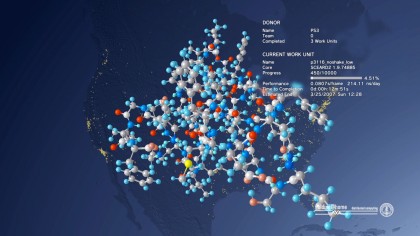10 ways everyday tech is changing the world
Is that an iPad or a surgical tool?

The gap between what an inventor sees as the main use for their creation and what people eventually do with is can be vast. Just ask Robert Oppenheimer. But some of the technologies that we're most familiar with have also been twisted into new uses - far from what their creators imagined. Here are ten of the most fascinating.
1. Smartphones as weather stations
The mobile phone in your pocket contains a lot of sophisticated sensors - for light, temperature, pressure, magnetic field and location, among other things. This data can be tremendously useful to meteorologists trying to forecast the weather, so British company OpenSignal has built an app called Weathersignal that collects this data from Android handsets and then uses it to improve forecasts. It's proved effective enough that the Met Office has expressed an interest in getting hold of the raw data for its own use.
2. Kinect for 3D scanning
Microsoft's Kinect sensor, originally built for games, has been hacked endlessly by developers keen to get access to its cheap-and-cheerful 3D capabilities, as seen in Buzzy electropop duo Avec Sans' video for Shiver.
Shortly after Kinect's launch, DIY electronics specialists Adafruit Industries offered a bounty for the first open-source drivers. At first, Microsoft closed ranks and said it refused to condone the modification of its products, but later it rolled back and said that the USB interface had been left open by design. Either way, Kinect is now used widely for cheap 3D imaging.
3. Wi-Fi for location
Wi-Fi networks are traditionally built for communication, and they're good at it - the technology has proliferated around the world for that very reason. But they're also used by companies like Google, Navizon and Skyhook Wireless to locate you effectively in urban areas.
After years of struggling with GPS chips, it's now much quicker and easier to locate you from what networks you can see around you, and how strong the signal is. As an added bonus, it even works perfectly indoors. The only place you now need GPS is far from civilization.
4. The theremin as an instrument

Here's a little-known-fact - the theremin wasn't originally intended to be a musical instrument at all. The spooky sounds it produces were the result of Russian research into proximity sensors in the 1920s, after the outbreak of the Russian civil war.
Sign up for breaking news, reviews, opinion, top tech deals, and more.
Its inventor, Léon Theremin, patented the device in 1928, then embarked on a grand tour of Europe playing his new creation to packed-out audiences. Eventually he found his way to the United States, where it became an instant hit.
5. Twitter in crisis situations
Among all the misspelt hashtags, rage and photos of what people are having for dinner, Twitter is really quite good at sharing information between large groups of people in emergencies. That's pretty far from its original goals as a status update tool, but it's been of tremendous utility following numerous natural disasters, political uprisings and other crisis situations. Most famously, the service been credited with the early organisation behind the 2010-2011 revolutions across the Middle East. Not bad for an app originally described as "a short burst of inconsequential information".
6. Minecraft in education

Swedish bedroom coder Notch knew he was onto a good thing when he created Minecraft, but he never imagined that his creation would be used by Google to teach quantum physics to the next generation of coders. That's the idea of qCraft, anyway, a mod for the game that introduces certain principles that are only possible at a quantum scale. It's not the only attempt to integrate Minecraft into education either - the team at Minecraftedu.com have a whole stack of ways to bring the blocky sandbox game into schools.
7. The Mosquito as a ringtone
It's difficult to outsmart a generation of children who've grown up with the technology that we're still fumbling around working out how to use. The best example of this is the Mosquito - an electronic device that generates a sound that can only be heard by young people. It was originally sold to prevent teenagers loitering in public places, but a campaign to ban it as an abuse of human rights fell apart after it was swiftly co-opted as a ringtone that couldn't be heard by teachers if it rang during class.
8. Loudspeakers as weapons

Speaking of sonic weaponry, militaries across the world have developed loudspeakers that can injure, incapacitate and torture opponents. Extremely high-power sound waves can damage the eardrums of a target, causing both pain and disorientation, while less-powerful noises can still be used for temporary crowd control purposes - police in Pittsburgh used sound cannons against protesters during the G20 summit. Ultrasound weapons may become part of our future too - tests on mice have shown lung and liver damage can take place above 184 decibels. Ultrasound is well beyond the range of human ears, so you'd never hear it coming.
9. iPads for surgery
Augmented reality apps have much promise for the world, but in most areas that promise has yet to be delivered. One exception is the use of iPads in surgery - German surgeons snapped a picture of a patient's liver with an iPad camera, then used pre-surgery scans to overlay details of where structures such as tumours and blood vessels were situated to help them find their way around. Being able to see the entire organ in three dimensions allowed the team to avoid damaging complications.
10. PlayStation 3 curing cancer

Finally, between March 2007 and November 2012, you could use your PlayStation 3 to contribute to the fight against cancer. Citizen science initiative Folding@home allowed PS3 owners to use the console's processor to crunch through protein folding simulations with high efficiency, delivering a 20x speed boost over PCs being used for the same task. During the time it was available, PS3 users contributed more than 100 million hours of computation to the Folding@home project, which the team behind it described as a "game-changer". No pun intended. We hope.
